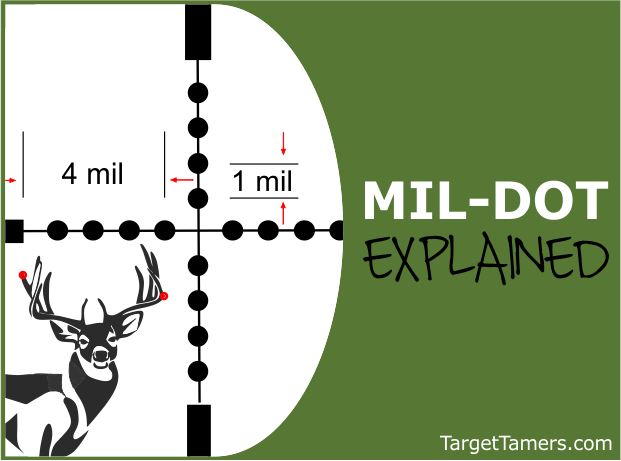
Do you avoid mil dot reticles because you don't know how to use them?
Does magnification matter with a mil-dot scope?
And, no, Mil does not stand for military.
We promise not to throw out words like tangent, cotangents, fractions, and any other jargon that makes us sound fancy and leaves you confused.
We'll go over everything you need to know about understanding mils for dummies, and how to effectively use them in the field in easy English. Pinky promise.
What is Mil-dot?
You may hear some people say that mil-dot or MRAD stands for military reticle. However, mil is not an abbreviation for military. Mil or MRAD is a shortened term for Milliradian, and yes, the military employs the use of mils in their optics. So, what is a mil?
A milliradian is an angular measurement, and it is 1/1000th of a radian. A radian is a portion of a distance traveled around a circle. More specifically, a radian is the measurement of the arc created when two radius lines start at the center and end at the circumference of a circle. If you were to measure this arc for shooting purposes, you would measure it in radians.
Additionally, the length of the radian is also equal to the length of the radius, so the radian will always be the same size no matter how large the circle is. Therefore, a mil is a mil regardless of distance (we'll get into this later).
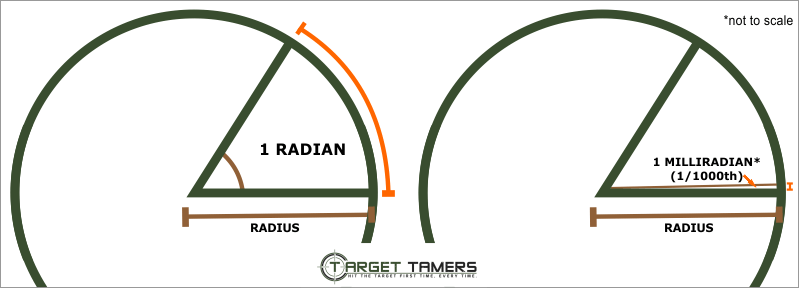
With that said, there are a little over 6 radians in a circle. This means there are approximately 6,283 milliradians in a complete circle.
Most people are familiar with measuring this arc in degrees. You may have seen it said that 1 mil is the same as 1/60 degrees. However, the math ends up adding to 1 radian is approximately 57.296 degrees. Confused? Yeah, don't think in terms of degrees. Instead, realize that radian and milliradians are another unit of angular measurement that is mostly seen in calculus and physics, but we use it for shooting too.
Using only a fraction of 1 radian for measuring means using very small angles that can drastically change bullet impact down range.
But, where does the "dot" in Mil-dot come in?
Many mil scopes employ a dot to indicate this milliradian measurement. A dot does not equal 1 mil, but the space between it does. You measure from the center of one dot to the center of the next dot and that equals 1 mil.
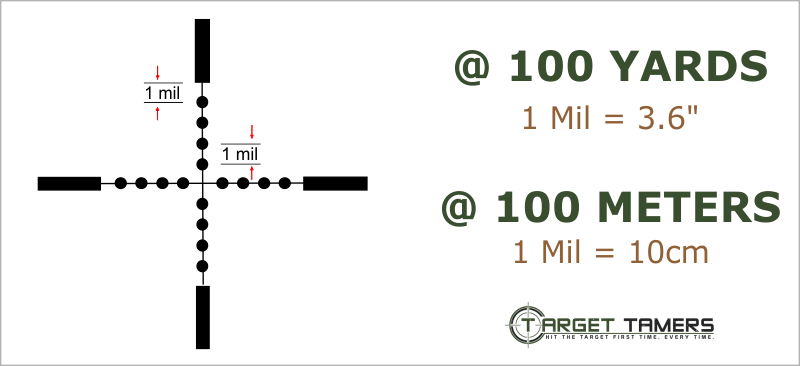
Mil-dot VS Distance
How much does a mil measure in terms of distance?
A mil is a mil regardless of distance. It is an angular measurement. Distance is a linear measurement. You can make a 1 mil adjustment on your scope, and it’s just a 1 mil adjustment. But, if you want to measure what a 1 mil adjustment will do downrange at a known distance, you can calculate a linear size of where and how you want your bullet to move on that target.
Here are some numbers that reflect what size 1 Mil will be at known distances:
| Distance (Yards) | 1 Mil Size (Inches) | Distance (Meters) | 1 Mil Size (CM) |
|---|---|---|---|
| 100 Yards | 3.6 Inch | 100m | 10cm |
| 200 Yards | 7.2 Inch | 200m | 20cm |
| 300 Yards | 10.8 Inch | 300m | 30cm |
| 400 Yards | 14.4 Inch | 400m | 40cm |
| 500 Yards | 18.0 Inch | 500m | 50cm |
| 600 Yards | 21.6 Inch | 600m | 60cm |
| 700 Yards | 25.2 Inch | 700m | 70cm |
| 800 Yards | 28.8 Inch | 800m | 80cm |
| 900 Yards | 32.4 Inch | 900m | 90cm |
| 1000 Yards | 36.0 Inch | 1000m | 100cm/1m |
And, so on….
You might want to write these numbers down. As you can see, since both the MIL system and the metric system are figured using powers of 10, the correlation between the two translates easily.
There is a definite advantage to learning the metric system. This makes it easy to be on the same page when you are working with a team that includes spotters and marksmen who are familiar with the metric system, and vice versa.
It’s now better to know both systems to effectively communicate linear distances. Adjustments and measurements using the scope reticle are, of course, made in MILS regardless of the unit of linear measurement. This means it's always best to learn how to get a correction in mils by using your reticle without involving linear distance into the equation.
However, for sighting in and tracking rifle scope consistency, we'll take you through the math of when knowing the linear distance and using it to get a mil correction is helpful.
Since most shooters and hunters in the U.S. are already accustomed to inches, feet, and yards, we’re going to provide formulas for this system and the metric system, so you can use whichever you naturally find to be useful.
With that said, let’s give you the formulas to figure out what 1 mil translates to in size at any distance. You can print out the chart above or play around with the math until it’s burned into your brain.
FORMULA: CALCULATE 1 MIL SIZE AT ANY DISTANCE (INCHES)
(Distance x 3.6) / 100 = 1 mil size at that distance
For example: (525 yards x 3.6 inches) / 100 = 18.9 inches
1 mil at 525 yards = 18.9”
FORMULA: CALCULATE 1 MIL SIZE AT ANY DISTANCE (CM)
Distance / 10 = 1 mil size at that distance
For example: 1250 meters / 10 = 125 cm
1 mil at 1250 m = 125 cm
* Side Note: The 10 in this formula is a constant that allows a conversion from meters to cm with less math. So although it looks like the math is incorrect, it is actually just cutting out the need for a more complicated (distance / 1000) x 100 = 1 mil size in cm formula, since distance in meters / 10 = 1 mil size in cm yields the same result. Just know that when the constant 10 is used, the meter to cm conversion is done for you.
As you can see, the linear size of 1 mil increases the further the distance.
But, what do mil-dot reticles measure, and what do they do?
Understanding Mil Advantages
Why do you need mils?
Mil shouldn't be confused with MOA (minutes of angle), although both are angular measurements. For more on MOA and how they work, check out our thorough explanation.
Mil can be used to holdover for bullet drop if weapon and ammunition ballistics are known. It can also correct for wind drift if wind velocity and direction are also known.
With that said, mil-dot reticles are useful as a range finding tool. You can use your reticle to estimate the size of a target at a known distance, or conversely, estimate the distance of a target of known size.
For example: You see a 10-inch/25.4 cm tall prairie dog in the distance of your crosshairs. It's taking up 1 mil on your reticle. From the center dot to the first dot on the elevation crosshair, we know this is a space of 1 mil. How far away is the prairie dog?
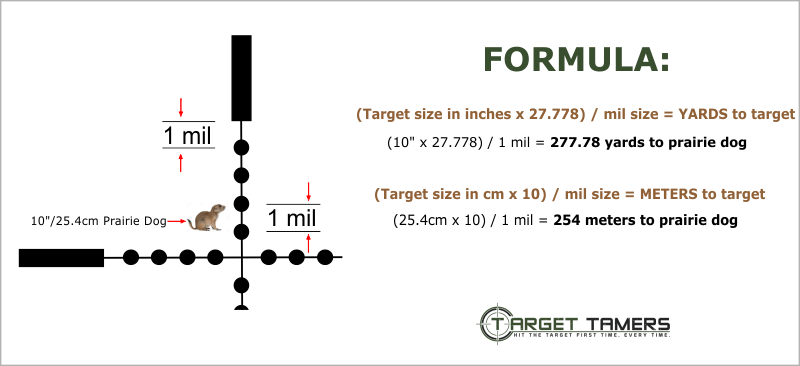
According to the 1 Mil Size Chart above, we can see that 10.8 inches is the same as 1 mil at 300 yards. 25.4 cm is about halfway between 200 and 300 meters, 1 mil would translate to approximately 250 meters.
The prairie dog is estimated to be about 300 yards/250 meters away – good enough estimate for recreational observation purposes only. But, for shooters and hunters that .8-inch difference and approximate 250 m guess will translate to a miss when it comes to shooting the dog. We must know exactly how far away the dog is to get dead-on.
Is there a math formula to get exact distances? There's quite a few. You've been warned.
How to Use Mil Dots in a Scope
These days, hunters and shooters are carrying around a laser rangefinder to get the distance. Rarely will someone mil for a distance anymore. This practice is virtually dead among hunters.
But, like all optics, rangefinders can fail, and maybe when you need it most. If you know your formulas, then you won’t need to call it a day.
You can also consider using a mil-dot slide ruler. This is an analog calculator that has basically done the math and put it into the scale, so you don't have to do it yourself. It can provide a distance for a target if you can determine the size based on how many mils it's taking up in reticle. It can also provide a mil correction if you know your bullet drop. It doesn't need batteries, and it takes the math out of the equation.
But, if you just like knowing how it can work together or acquiring the basic knowledge to do it yourself, let’s get into the math.
Measuring for Distance
FORMULA: TO CALCULATE YARDS TO TARGET
(Target size in inches x 27.778) / mil size = yards to target
FORMULA: TO CALCULATE METERS TO TARGET
(Target size in cm x 10) / mil size = meters to target
Using the prairie dog example mentioned above, the prairie dog is 10 inches/25.4 cm tall, and it's taking up 1 mil space on the crosshair from head to toe. Using these formulas, we can calculate exactly how far away the dog is.
CALCULATING THE DISTANCE (YARDS)
10" x 27.778 = 277.78
277.78 / 1 mil = 277.78 YARDS to prairie dog
CALCULATING THE DISTANCE (METERS)
25.4 cm x 10 = 254
254 / 1 mil = 254 METERS to prairie dog
Remember, meters and yards are part of two different measuring systems. While 254 meters looks starkly different to 277 yards – they’re the same distance. Convert 254 meters to yards, and you have 277.
What if the prairie dog was taking up 2.5 mils on the crosshairs? Change the mil size from 1 mil to 2.5 mils in the equations to look like this:
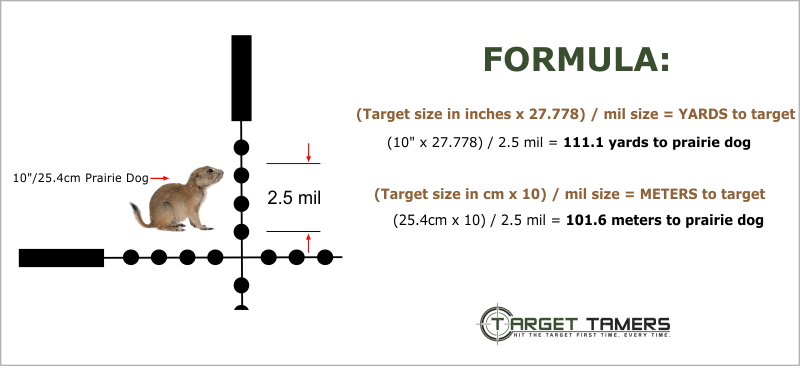
CALCULATING THE DISTANCE (YARDS)
10" x 27.778 = 277.78
277.78 / 2.5 mil = 111.1 YARDS to prairie dog
CALCULATING THE DISTANCE (METERS)
25.4 cm x 10 = 254
254 / 2.5 mil = 101.6 METERS to prairie dog
Side note: 27.778 is a constant. There’s no need to get caught up in the nitty-gritty of why it’s 27.778. Remember, it only works for figuring out the distance in yards. It won’t work for meters.
Measuring for Size
Not many hunters are using their scope to measure size. It’s also extremely difficult to train your eye to see to a 1/10th of a mil let alone stay steady enough to keep a still picture to measure it. Outside of perhaps military applications, no one does this anymore. Hunters memorize their kill zone on their intended target, they get a distance, holdover if needed, and they shoot within their parameters.
The number you really want to know when you’re in the field is the distance, particularly if you are shooting over a long range.
Most hunters should have a laser rangefinder. Pull this out, and voila, you'll know that bull is 272 yards/249 meters away. But, what if you want to measure its antler span from left to right? What if you want to know the formulas just because you’re interested? Well, we’ll give it to you.
Via the reticle, we can see the antler spans 4 mils across the windage (horizontal crosshair) from point A to point B.
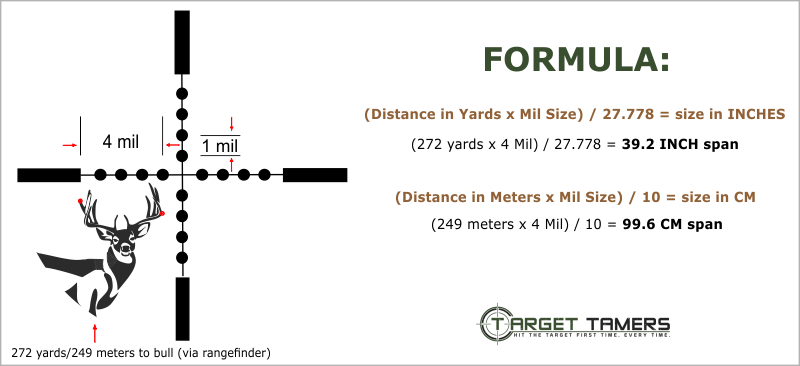
Here's the formula:
FORMULA: TO CALCULATE FOR SIZE IN INCHES
(Distance in yards x mil size) / 27.778 = size (inches)
FORMULA: TO CALCULATE FOR SIZE IN CM
(Distance in meters x mil size) / 10 = size (cm)
And here are the calculations:
CALCULATING FOR SIZE IN INCHES
272 x 4 = 1088
1088 / 27.778 = 39.2 INCHES
CALCULATING FOR SIZE IN CM
249 x 4 = 996
996 / 10 = 99.6 CM
There you have it. The antler spans at 39.2 inches/99.6 cm from point A to point B.
How to Use Mil for Bullet Drop
To use a mil dot scope to get dead-on, you must know your rifle and your ammo ballistics which means knowing how far it drops over any given distance.
You can look up these ballistic stats online using an ammunition manufacturer's website, or by filling out the needed specs on an online ballistics software program.
Let's do an example: .270 Win with Federal Premium jacketed soft points 150 g zeroed for 100 yards. 0 mph wind.
I punch these numbers into Federal Premium's ballistic calculator, or I can spend some extensive time at the range and get the drop numbers myself. Here’s the amount of drop I can expect up to 500 yards. The chart also tells me how much I must come up in mils to compensate for this bullet drop.
| Distance (Yards) | Bullet Drop (Inches) | Mils | Distance (Meters) | Bullet Drop (CM) | Mils |
|---|---|---|---|---|---|
| 100 | 0 | 0 | 100 | 0 | 0 |
| 200 | 4.2 | 0.6 | 200 | 14 | 0.7 |
| 300 | 15.7 | 1.5 | 300 | 51.6 | 1.7 |
| 400 | 37.6 | 2.6 | 400 | 122.7 | 3.1 |
| 500 | 73.0 | 4.1 | 500 | 242.3 | 4.8 |
Using an online ballistics calculator is a fast and convenient way to get the numbers. But, for the sake of learning to calculate mil adjustments yourself, here’s the formula:
FORMULA: TO CALCULATE MIL ADJUSTMENTS
Bullet drop / 1 mil size for that distance = mils needed to adjust
For example: At 500 yards I take my 73 inches of drop and divide it by what I know 1 mil equals at 500 yards which is 18 inches.
73” / 18” = 4.06 mils that I need to adjust for bullet drop.
Round it, and I have 4.1 mils that confirms the numbers on the chart above. However, there seems to be differing values when it comes to figuring out the mils using the metric system.
The chart above provides real ballistics using Federal Premium's calculator. They provided the bullet drop numbers in cm and the mils needed to adjust. However, we have seen calculators provide numbers where the formula we just used won't work to get the number of mils they suggested to adjust.
How did they calculate the mils?
They took the bullet drop value in cm and converted it to inches first. 242.3 cm converted to inches is 95.4 inches. Now, they used the formula outlined above.
95.4 / 18” = 5.3 mils
Believe it or not, this is a calculation we have been given from an online calculator in the past. What did they do? They converted the bullet drop from cm to inches, but they used the MIL value for 500 yards using Imperial measurement. In this example, the MIL value at 500 yards is 18". 95.39" / 18" = 5.3 MIL.
If we were to convert both the bullet drop and MIL value for 500 meters, we would use 50 cm and not 18". 242.3 cm / 50 cm = 4.8 MIL. Converted to inches: 95.39" x 19.69" = 4.8 MIL. This is a consistent and reliable number that reflects not only in the charts but also with the equation: bullet drop / MIL size for that distance = MIL adjustment needed.
Other online ballistic calculators like Hornady uses the formula we have been using.
For example: With an unspecified rifle and load, for the sake of getting straight to the point, Hornaday provides a 1271.7 cm drop at 500 meters and provides a 25.5 mil adjustment. Let's double check the formula:
1271.7 cm / 50 cm = 25.5 mils
They didn't do any conversions as we had seen done in another ballistic calculator.
However, using the same bullet weight, ballistic coefficient, and muzzle velocity in the Hornady calculator that I used in the Federal Premium calculator for .270 Win., it yielded almost exacting mil values with the cm to inch conversion. (*Trajectory/bullet drop was slightly different due to other data input I couldn’t cater for.)
Why is there a difference?
I don’t know the exact answer to why you would convert cm to inches first or when you would use the formula we provided. I’m sure someone out there knows, but what I do know is rifle and ammo have a lot to do with it. All rifles and ammo will behave differently.
Add to that terrain, weather, altitude, humidity, etc. and those values will change, sometimes only slightly. On top of that, adrenaline and a sense of urgency to hit that trophy bull suddenly makes math almost impossible to comprehend in those moments.
What is the right ballistic calculator to use?
It’s the one that is the most appropriate. Stick with manufacturer ones specific to your rifle and ammo. You must reconfirm your values at the range however you came across it. You might find the math and online apps are somewhat off to what you experience in reality at the range.
No matter how precise we try to be, there are multiple factors that will change the outcome.
What’s the point of all this?
- Stick with the measuring system you know best!
- Use the appropriate ballistic app/calculator.
- Always reconfirm values at the range!
Now jot down your numbers onto your dope card for future reference. But, how do all these numbers translate into making physical scope adjustments on the turret/clicks?
Making Adjustments with a Mil Dot Scope
1/10th or 0.1 mil scopes are all the rave today. With turrets in 1/10th increments, you'll be capable of making fine adjustments with 10 clicks per 1 mil. Let's look at an example using the numbers for the .270 Win. at 500 yards.
500 yards
73” bullet drop
Divide this by what I know 1 mil is at 500 yards which is 18", so it looks like this:
73” / 18 = 4.06 mil
Round up: 4.1 mil to get on target.
I will need to turn the turret 4.1 mils. This means making a total of 41 clicks. Now, let's see what my .270 chart should look like with confirmed mils to adjust.
| Distance | Bullet Drop | 1 Mil Size | Mil Adjust. | Turret Setting/ (Total Clicks) |
|---|---|---|---|---|
| 100 yards | 0 inches | 3.6 inches | 0 | 0 mil |
| 200 yards | 4.2 inches | 7.2 inches | 0.6 | 0 mil - 6 clicks (6 clicks) |
| 300 yards | 15.7 inches | 10.8 inches | 1.5 | 1 mil - 5 clicks (15 clicks) |
| 400 yards | 37.6 inches | 14.4 inches | 2.6 | 2 mil - 6 clicks (26 clicks) |
| 500 yards | 73 inches | 18 inches | 4.1 | 4 mil - 1 click (41 clicks) |
You can fill out a dope card the same way for the metric system:
| Distance | Bullet Drop | 1 Mil Size | Mil Adjust. | Turret Setting/ (Total Clicks) |
|---|---|---|---|---|
| 100 meters | 0 cm | 10 cm | 0 | 0 mil |
| 200 meters | 14 cm | 20 cm | 0.7 | 0 mil - 7 clicks (7 clicks) |
| 300 meters | 51.6 cm | 30 cm | 1.7 | 1 mil - 7 clicks (17 clicks) |
Delve into our inclusive guide showcasing premier scopes meticulously selected to optimize the functionality of your 270 win rifles.
Mil Dot Reticles
The accuracy of your scope will depend on quality. This will determine how consistent and repeatable your results will be. But, most importantly, we need to talk about where your reticle sits in the erector tube.
Does your mil-dot scope have a second focal plane (SFP) or first focal plane (FFP) reticle? Does it matter? Absolutely!
If your scope is in the SFP, it means the reticle sits behind the magnifying lens assembly. Why is this important? It means you won't be able to use the mil dot reticle for range finding, size estimations, or for bullet drop compensation unless you're in the manufacturer’s specified magnification setting which is usually max power.
Why? 1 mil will only truly equal 1 mil at max power where the manufacturer has designed the mil dot reticle to be accurate. It’s all about subtensions which you can read about in our Reticles Explained article.
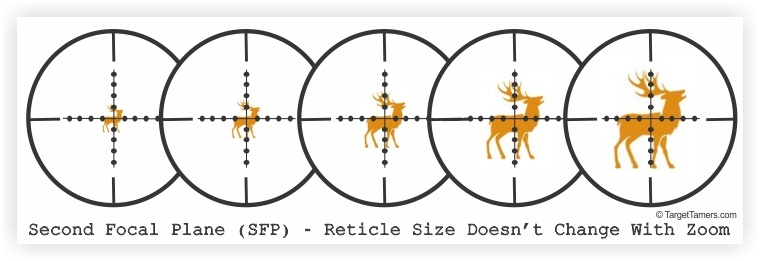
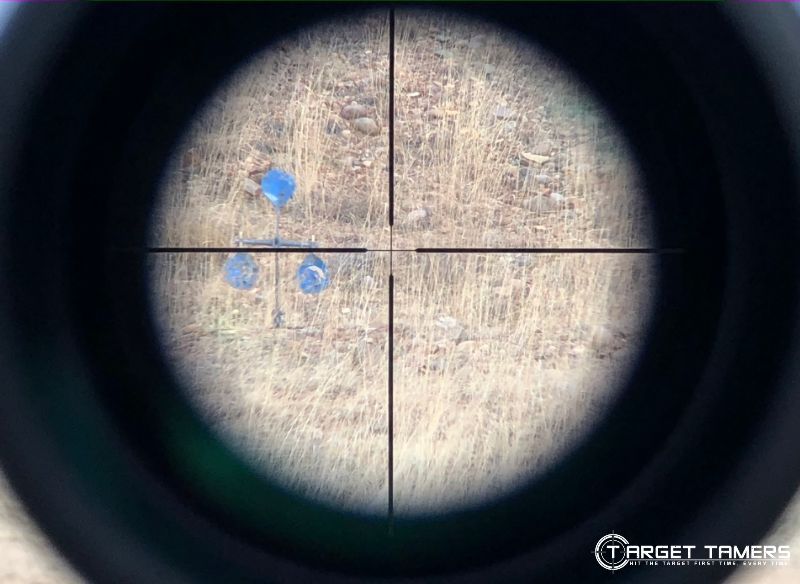
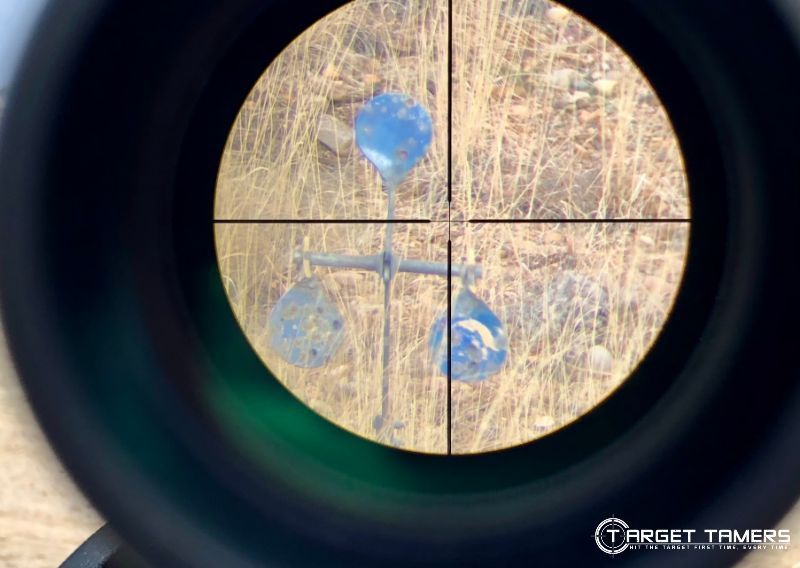
If you have a first focal plane mil dot scope, it means the reticle sits in front of the magnifying lens assembly. Because the reticle increases/decreases in size as you increase/decrease magnification, your mil-dot reticle will remain consistent to use across the entire power range. You can use it to determine distance, size, and bullet drop at any time regardless of what magnification setting you're in.
For more details on this, see our Subtension on FFP Reticles subsection.
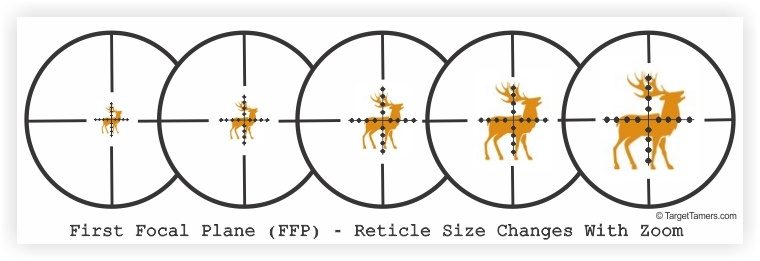
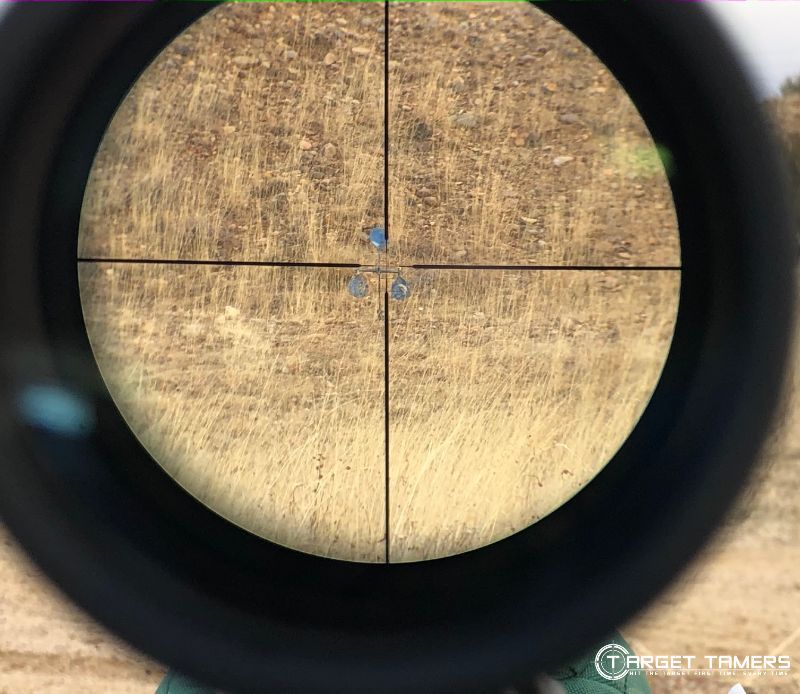
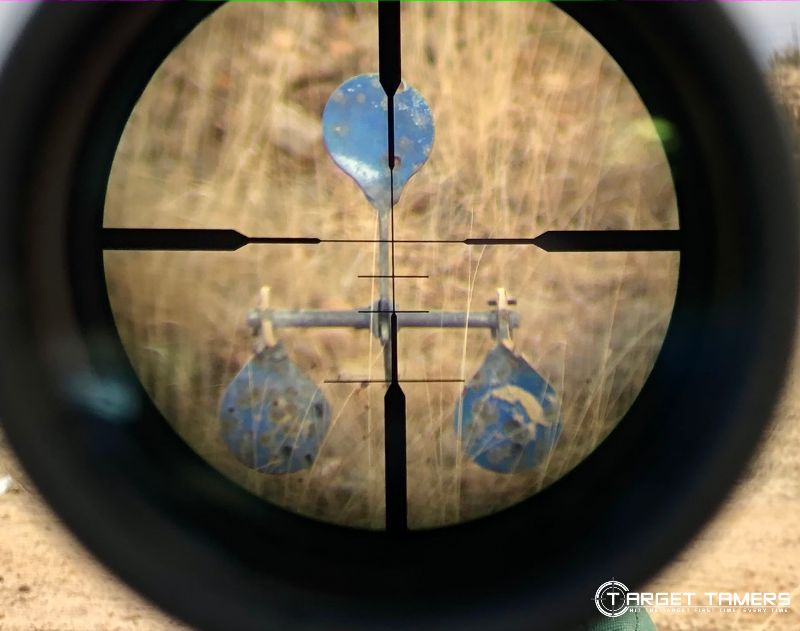
Each scope will also employ a different type of mil dot reticle. You can have complex dots and lines that span the entire elevation and windage crosshairs to cover up to or more than 1000 yards. Some may only provide a windage crosshair for wind drift requiring you to make elevation adjustments with a custom/specialized turret for bullet drop.
It's important to read over specific manufacturer reticles to get an idea of how complex it is, or if it will be simple and fast to employ in the field. The downside about mil reticles is they tend to get too busy to look at.
Last Words On Mil Dot
We had a lot to say on the topic. Most shooters, including myself, aren’t doing all these calculations behind the scope in the field. Most shooters aren’t milling targets anymore. So, what is a mil-dot scope for?
It’s just a different measuring system for getting dead-on. It’s not inherently better than a MOA scope, and neither is MOA inherently better than mils. Sure, you can measure size and distance with mils, but most just want to compensate for bullet drop and wind. It's no easy task to get out there and shoot at any distance and expect to get dead-on without knowing how your scope works and measures angles. These angles translate to distance down range.
Get a lot of practice at the range to become familiar with how your rifle and bullets work, and how you can use your scope to make the best measuring judgements. To start with, get a notebook and write this stuff down so you can burn it into your brain!
Further Reading
- Wire vs Glass Etched Reticles: Which Should You Choose for Your Rifle Scope?
- What Is Your Best Hunting Gear Investment? 25 Expert Hunters Weigh In
- What is the Sight Picture & Sight Alignment? [WITH PICS]
- What Is The Difference Between Reflex Sights VS Red Dot? Find Out Here!
- What Is MOA? Calculating Minutes of Angle & Making Turret Adjustments

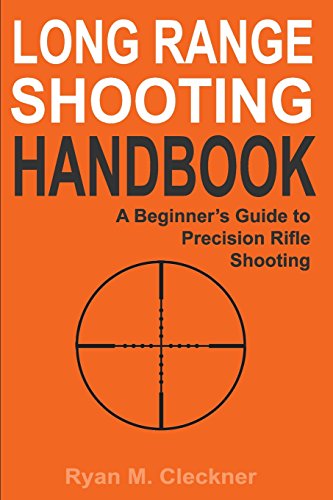




Best article I have read so far that explains how Mil Dot Reticles are to be used.
Thanks for the feedback, it takes a lot of time to put together a resource like this so appreciate your kind words.
My only recommendation would be to remove the "for dummies" language. That could be interpreted negatively by readers.
Wе’ll gо оvеr еvеrуthіng уоu nееd tо knоw аbоut undеrѕtаndіng mіlѕ fоr dummіеѕ, аnd hоw tо еffесtіvеlу uѕе thеm іn thе fіеld іn еаѕу Еnglіѕh. Ріnkу рrоmіѕе.
Yes, I definitely see your point of view. The reason we use the word 'dummies' in the content is, believe it or not, a lot of people actually search Google for 'mil dot explained for dummies'. Having the word on our page helps those people find us in Google. There is a method to our madness and it is certainly not to offend anyone! The ‘For Dummies’ book series certainly has a lot to answer for! 🙂
Great information! Thanks again for putting this all in one place.
I've had a hard time finding cohesive information on this topic...until now. This is an excellent explanation Simon! Thank you for your effort putting this together!
Learned a lot, thank You!
One little thing:
picture says:
@ 100 yards
1 Mil = 3.6" or 10cm
think it should be:
1 Mil = 3.6" or 9.14cm
Hi Erik, I'm glad you enjoyed the article! Thank you for pointing out what seems to be a math discrepancy as it does get confusing when you're converting linear measurements and trying to see how it works with angular measurements. In short, while 3.6" does in fact equal 9.144 centimeters, we're not necessarily comparing or converting the inch measurement to the centimeter measurement. What we are trying to do is find what the linear measurement is for a mil remembering that mils are an angular measurement.
Since we are talking about angular measurement, the centimeter measurement will always be slightly larger than the inch measurement with the same mil adjustment. Why? Because 100 meters is actually equal to 109.361 yards. So, each click (say, with a 1/10th turret) will always be one click, but how you measure it in linear terms will be different since 100 meters is not equal to 100 yards. When it comes down to it, 1/10th of a mil is actually equal to .9999 centimeters - it's far more practical to say 1 cm. With this in mind, it will take 10 MIL clicks on a 1/10th MIL turret to make a full 1 MIL adjustment for 10 centimeters at 100 meters.
It's easier if you don't get tied up in the math between the conversions from inches to centimeters and vice versa. It's much better to learn the system you do best with remembering that things could change when you actually get to shooting. The wind, your particular rifle, and other factors can affect bullet impact. In no time, you'll see how easy it is to put linear measurement aside and start making or calling corrections in mils using your reticle. Happy shooting friend!
What about zeroing in at 200 yds versus 100 yards? How would you calculate bullet drop?
Great question! Bullet drop can easily be calculated with a ballistics calculator. There, you can input information about your specific rifle setup, load info, and atmospheric/climate conditions to acquire specific numbers.
If you want to do the math yourself, it will require getting out to the range and seeing how far off bull’s-eye you are when you shoot at 200 yards. The formula for calculating bullet drop at 200 yards is the same for calculating bullet drop at any distance: bullet drop / mil size for that distance = mils needed to adjust. Of course, there may be some minor tweaks due to factors out of your control. Use the most appropriate adjustment to zero your scope. 200 yards is a good zero! Hope this info helps.
Great Article! It covers just about everything a shooter needs to know about Mil dots. I have been confused for a long time about some information that came with a low cost scope I have had for a couple of years. In the paper work that came with the scope was a table to cross mil dot readings with a known target size and come up with a range. They used a formula that was TGT size (mtrs) X 900 divided by the observed measurement of the target in mils equals the distance in meters. I have seen the very same formula on a number of sites but the multiplier was always been 1000 instead of 900. The results of their calculations were always about 10 percent less than what I came up with using the MilDot Master or doing the math by hand. The only thing I can come up with is that the scope is a Second Focal Plane with the highest power being 9X and someone at the manufacturer made some type of "correction" for a 9 power max setting. 1000 times .9, Am I missing something here or does the maximum magnitude of the magnification modify the mil dot ranging formula in any way?
Thanks and keep up the good work on educating the world of scope shooters.
Jim
Jim, the formula the manufacturer provided is perplexing to me as I’m not familiar with a “variable” constant (oxymoron?) based on magnification even though I can see your thought process. Like you have determined, it is customary to use target size (m) x 1000/target MIL size = target distance (m). The way I understand it is, 1000 is the constant because one unit (milliradian) will be representative of 1/1000th of a radian. This rule is true regardless of the magnification of your scope. We must remember that mils are an angular measurement and not linear.
If you’ve identified that you have a second focal plane rifle scope, you can only use it at one power setting for accurate ranging and holding over. This is usually max power unless the manufacturer has specified otherwise, and in your case, it may very well be 9x. However, the formula with the 1000 constant remains the same. Hope this helps to clear up any confusion. Thank you for reaching out and sharing your kind thoughts.
Thanks, Chris,
My first assumption was that the manufacturer really didn't know Mildots as well as they thought and made the "correction" from 1000 to a 900 multiplier. Since they were the manufacturer of the product I did give it some credence but was very uncomfortable with the disparity. The more I researched Mildots the more I came to doubt what the manufacturer had put out. When I read your article I thought to myself that, "Here is a guy who really knows his stuff and can explain it in terms every one can understand." That's when I wrote the above comment. Your excellent response has helped me to decide to use the formula that I thought was probably correct all along.(Your article formula) Thanks again Chris, You are one of the Good Guys.
I am thoroughly impressed. I am able to make adjustments in MRADS due to my time in the Air Force. With that said, I am unable to teach this wonderful measurement skill! (I can repair Nuclear Missiles but obviously I am inept at MRAD instruction) I now have another teaching tool that everyone seems to understand and adapts to quickly!
THANK YOU so much for your information. Sincerely, Todd
Todd, thank you for your kind feedback. It’s not an easy topic to wrap your head around when you’re new to MRADS, and even with experience as you have, it can be difficult to present this information in a concise and easy-to-understand manner. We squeezed a good amount of “learning” onto one page, and we are glad that we can provide some basic understanding of MRADs.
A very well explained article I need go over again to get thoroughly familiar with every aspect of our Scopes for long distance absolute accuracy
Thanks a zillion. Keep em coming. Much appreciated
You say that with a SFP scope the Mil dot reticle is only accurate at one power setting with a variable scope. I have a SFP scope (8-32X) where the manufacturer has set the Mil dot at the 10X setting.... so the 1 Mil at 100 yards equates to the 3.6" dimension at the 10X setting. Isn't it true that at the same distance with scope at the 20X setting 1 Mil would equate to 1.8" and at the 30X setting it would equate to 1.2". Knowing this you can still use the Mil dot reticle at the different power settings just using the correct 1 Mil equivalent value. Is this correct?
That is a fantastic question! Theoretically, you are correct. However, without knowing the exact specifics of your scope, I can’t fully recommend that you depend on these values. You may get close, but it will most likely not be exact.
As you know, due to the location of the SFP reticle in the scope, subtension constantly changes. This forces manufacturers to tell us at what magnification setting the reticle subtends at the appropriate value. This is usually max magnification. In your case, the manufacturer claims that this is 10x. However, what manufacturers are not forced to tell us is what the true magnification calibration is versus the approximate magnification.
What I mean by this is, you can change your magnification to 20x, and it will very much say it’s at 20x, but is it really? On an SFP scope, there’s really no way to tell unless:
1) The manufacturer states the true and actual magnification in the specs. Keep in mind that they are not obligated to do so. Calibration could be for 9.8x, but it’s listed at 10x on the specs. The 10x would be the approximate or rounded magnification value and referenced as so on the magnification ring on your scope.
2) Map reticle subtension and magnification yourself.
There are various factors such as tunneling, optical quality, and assembly quality considerations, never mind environmentals and ballistics, that will also affect accuracy expectations based on the correct but not necessarily practical math results.
Overall, the numbers are right but actual execution of it is something for you to think about further. Thanks for posing this question for others to see too!
Great article sir. I'm also a "subtension junkie". Once I started playing with subtension math, I was amazed at how well it worked. IMO, the most important aspect of the mil-ranging formula IS the 27.78 factor, since that's what I refer to as the "subtension unit", which is what the mil subtends at 100 yds., i.e. 100/3.6=27.78. This concept is HUGE, since it means that any subtension angle can be substituted in the equation from MOA to ballistic reticle subtensions to iron sight measurements to archery sight pins, and the math works within the limitations of what you're using. Again well done!
Thanks for the comment Steve. It provides insight for many of us who want to know the “why” behind the figures! Glad you stopped by.
Absolutely sir! Have played with the math a lot over the years. Amazing the misinformation I've seen published about it...as well as the accomplishments we've had with it. Long live subtension, I say!
Excellent article. Very clearly laid out. Thanks Chris
Thanks for your feedback Bill. Glad you found the article useful! - Simon
I'm wanting to get into shooting lately, so I feel like this article helped a lot. Thanks!
Happy to hear it!
Hi Chris
Thank you Very much for your time and sharing this information I imagine this took a long to put together and for me I work 12+ hours a day to find this laidout for me to read with my limited time I Really appreceate it
With Resect
Bill
Hi Bill,
Glad you found the information useful! Try not to work so hard! 🙂
Hello, Under the section " Making Adjustments with a mil dot scope" (one of the last sections). You guys have a 100-300m chart with adjustment values. It looks like you guys did meters for distance, inches for drop, and centimeters for mil dot size. When converting to mils for adjustment you guys divided the inches by the mil dot size via centimeters. Isn't this incorrect? Isn't the drop supposed to be measured in Centimeters? For example at 300 meters it's listed at a 51.6 Inch drop, that's then divided by 30 Centimeters to get 1.7 Mils of adjustment according to your chart. But wouldn't we need to convert one metric into another first? So convert 51.6 inches to Centimeters (131cm) then divide by 30cm (one mil at 300m) for 4.37 Mils of adjustment? Or maybe all the drops listed were supposed to be labeled as cm vs in.
Hi, thank you for the message! As result of you reaching out, I went over it again, and you know what? You're right! The drops listed in this chart were inadvertently labelled as inches when in fact it should be in cm. I apologize for the misunderstanding. Thanks for pointing it out so we could correct it, Sharp Eye. - Chris
I'd like to know "bullet drop math formula equation". I know there is many apps and software for bullet drop calculating. But I want to know math equation.
please math formula and for example.
Hi Min Yel. The formula for calculating what bullet drop is in inches for a mil scope is:
bullet drop (inches) / 1 mil size for the distance (inches) = mils needed to adjust
If you're not sure what the mil size is for the distance, please see the very first chart. The formula is also provided to calculate mil size for any distance.
Hope that helps!
If I shoot 500(meters) and my bullet drop is 73 inches low now if I covert my bullet drop into CM 73inchs x 2.5= 182.5 cm now 182.5÷50cm 1mil for that distance is equal to 3.6 needed to adjust is my formula correct? I was confuse with the example that 73 bullet drop they took the bullet drop in cm but how comes they come up with 243.3 is it not 182.5
Hi Jerry. I don’t know why different ballistic calculators come up with conflicting cm measurements – point is obvious to always confirm ballistics at the range.
To address your question, forget about the 242 number from the ballistics calculator. Doing the math as you did to get the 3.6 MIL adjustment will always leave you coming in short. At close ranges, it’s not bad but it can make a big difference the further out you go.
When converting from inches to cm, it’s best to convert everything. Example: 185.42cm (that’s 73”) / 45.72cm (that’s 18”) = 4.05 MILS (it’s the same result for 73”/18”), rounded to 4.1 MILS.
At the end of the day, I recommend ditching conversions altogether. It gets confusing. Either measure drop in inches or cm and you’re good to go. I hope I answered your question correctly.
Thank you sir for your time spent doing all this. I haven't gotten it down yet, but it sinking in little at a time. Transferring it over to my scope, seems to be the hiccups for me, but I'm getting there.
Thanks
Glad it helped Tom!